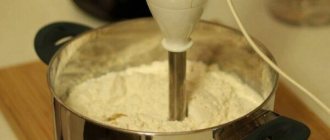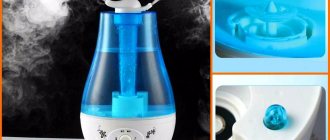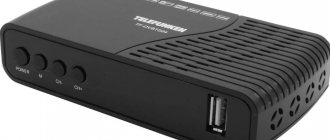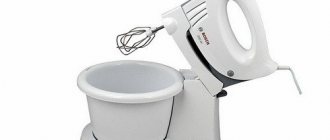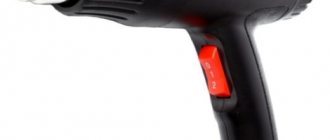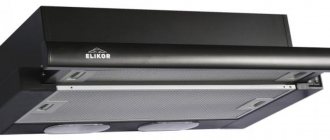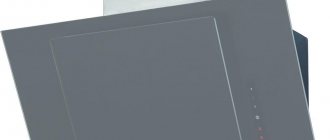No. 1. Which mixer design should you choose?
Today, all mixers, no matter how different they look, can be divided into three main types depending on their design:
- two-valve - a classic version with two taps for supplying hot and cold water;
- single lever , when using one lever you can regulate both water pressure and temperature;
- contactless ones do not require direct contact, as they turn on only when you raise your hands.
Single-lever faucets are considered the most popular today , because they are really convenient to use, and you can regulate the pressure and temperature of the water with just your little finger. With such a mixer, it will not take time to adjust the desired temperature, which means you will also save water. If necessary, you can stop the water supply instantly by simply lowering the mixer, rather than turning the taps.
, two-valve faucets today are much inferior to single-lever faucets. They are usually used either by conservatives who are accustomed to such a device, or by those whose kitchen is designed in a classic style, and a single-lever mixer simply will not fit into the overall interior.
Contactless or sensor faucets are the most convenient and economical option, but due to their price, they are not the most common in domestic kitchens. Water flows from such a faucet only when there is some object or human hands in front of it. If you remove the object, the water will immediately stop flowing. Not a single drop of water will be spilled in vain, and there will be no need to worry about forgetting to turn on the tap. And what convenience does such a mixer provide during cooking and washing dishes, when there is no need to touch the device with dirty hands, thereby dirtying it.
Design Comparison Table
Products are classified into:
- Valve - equipped with two handles, practical and durable.
- Ball valves are a ball with several holes. They have the functions of turning in different directions, raising and lowering.
Replacing gaskets in a ball mixer is more expensive than in a valve assembly.
By type of design, products are divided into:
1. Single lever.
2. Two-valve.
3. Thermostatic.
4. Sensory.
This table shows the most important pros and cons of modern devices.
| Construction type | pros | Minuses |
| Single lever |
|
|
| Two-valve |
|
|
| Thermostatic |
|
|
| Contactless |
|
|
Touchless faucets are not a suitable option for the kitchen because:
- When cooking, you will need different temperatures. However, touchless appliances supply either hot, cold, or summer water. That is, the housewife will have to constantly adjust the pressure and temperature of the water, wasting her time.
- In order to fill a large pan, vase, or teapot, you will need to hold your hands over the container for several minutes. And this, you see, is not very convenient.
No. 2. What material to choose a mixer from?
Today you can find faucets on sale made from materials such as:
- metals and alloys , incl. steel, nickel, bronze, brass;
- ceramics;
- granite;
- plastic.
Faucets made of bronze or brass - they are not affected by water, and they look expensive and luxurious.
Steel faucets are also an excellent material, maximally balanced in price and appearance.
To make it easier to care for your faucet, it is recommended to choose a chrome-plated type of surface rather than a shiny one: dried drops will not be as visible, and such faucets look more expensive.
There are also faucets made of an alloy of aluminum and silicon - silumin . They are quite inexpensive, but not very durable . By the way, unscrupulous manufacturers use some parts made of silumin, hiding it. You can identify such a mixer by its light weight.
The most practical faucet is one whose internal elements are made of ceramic and external elements are made of metal .
Ceramic faucets look very attractive in appearance and go well with stone and porcelain stoneware countertops. In terms of reliability, ceramic faucets are inferior to metal ones, and their service life is much shorter.
Granite faucets are a rarity in our market, and they are purchased mainly by those who have a sink made of granite.
Faucets made of plastic are resistant to water, aggressive environments, and are not subject to corrosion. But at the same time, it is a very fragile material that can hardly be called durable. This option may be suitable for a country kitchen where the mixer is not used all the time.
No. 3. Spout size and shape: which one to choose?
The faucet spout is an important parameter for the kitchen, since the convenience of using the sink for washing dishes, vegetables, etc. directly depends on it. Here the approach is radically different from choosing a bathroom faucet. It is important that the stream of water hits directly the center of the sink, preventing splashing. The height of the spout should be such as to easily draw water into containers, wash vegetables, large dishes, etc. The choice of spout height directly depends on the depth of the sink . So, if it is not deep enough, then the spout should be higher, but do not overdo it, otherwise the water will splash. If the sink is deep, then you can choose a low mixer. It is most convenient to buy a faucet complete with a sink and all accessories so that the products are as functional and practical as possible.
As for the shape of the spout , in this case it is better to base the choice on your own preferences and features of the kitchen interior. Manufacturers offer so many conceivable and inconceivable options that your head can spin: there are S-, L-, R-, J-shaped faucets and other models with a unique design.
Spout height and shape
When choosing the height of the spout, you should proceed from the depth of the sink. The standard rule applies here: the deeper the bowl, the higher the spout can be.
However, there is no need to go to extremes either: a spout that is too short in a small container will not allow you to collect liquid or wash a deep container. One might assume that it is correct to choose a tall faucet for a small sink, but this is also incorrect. This solution, of course, will eliminate the problem of filling the pan, but the splashes, hitting the bottom of the sink from a great height, will scatter to the sides.
It is important that the stream falls exactly into the center of the bowl. If it is located close to the back wall, then water will constantly flow behind the sink. And if the gander is located close to the outer wall, then it is possible that moisture will get on the floor.
It is preferable to purchase a “sink + mixer” set from the manufacturer. In this case, all parameters have already been selected optimally.
An excellent solution would be to purchase flexible systems. They are sold in three variations:
- The spout is on hinges - it is a movable structure made of several tubes connected to each other (pictured). Thus, the user can independently select the height and angle of the flow. Naturally, the presence of additional joints increases the risk of leaks. Therefore, choose products only from reliable manufacturers.
- Retractable - inside the faucet there is a flexible hose, which, if necessary, extends forward by 1 - 1.5 m. Here it is important to pay attention to the connection between the retractable element and the base: it must be reliable. Some models have an additional shower-like hose that is installed next to the main one.
- Flexible - the inner hose is made of soft material, enclosed in a flexible holder. This is an inexpensive option that is very convenient, but due to its specific appearance it is not suitable for every interior.
The spout shape can be any: straight, curved, arched. It all depends on personal preferences and the design of the room.
No. 4. Lever on the side or on top: which is more convenient?
In this case, we are talking exclusively about single-lever models, in which the control lever can be located on the side or above the mixer. In principle, the location depends on the height of the spout. In most cases, a faucet with a high spout is complemented by a lever on the side, and a low spout - on top. In terms of convenience, they are exactly the same, but still a lot depends on personal preferences.
It is worth noting that the lever located on the side is a little more practical , since water or detergent particles will not drip onto the mixer itself, which means maintenance will be easier.
No. 5. Where to mount the mixer?
Before choosing a mixer, do not forget to pay attention to the features of its fastening. So, it can be installed:
- on the kitchen countertop , and then a hole of a certain diameter is cut in it;
- on the wall;
- on the sink itself , if there is a hole there.
Each mixer is adapted to a specific type of fastening, so this important parameter must be taken into account. If all the elements of the future kitchen are selected at once, then the task is simplified.
Mixer installation location
There are three ways to install the mixer:
- at the car wash;
- on the wall;
- on the countertop next to the sink.
Each option has its own advantages and disadvantages. The most common option is installation on a sink, for which most sinks have special holes. Wall mounting is the most inconvenient, since you need to run pipes under it and hide them under the decorative panel. However, this option is quite good for work; it allows you to raise the spout higher above the sink. This expands the ability to clean and handle large items.
No. 6. Angle of rotation
No one can argue that a large angle of rotation of the mixer is great, because in this way you can conveniently wash vegetables and fruits, any dishes, draw water into a container and perform other tasks. Today, most budget and mid-price mixers can be rotated 140 degrees , which is quite enough for convenient use.
In more expensive faucets, the rotation angle can reach 180 degrees and even make a full revolution around its axis . The last faucet will be indispensable if the sink is located on the kitchen island, but otherwise it is useless.
No. 7. What else can faucets do?
Today, technological progress has even affected faucets. It would seem that what else can be added to them, since they are assigned only one function? So, today you can find products on sale with the following additional functions:
- mixer with pull-out spout. This is actually a faucet with a shower: in its normal state it looks quite ordinary, but if desired, you can remove a small shower from it. With this function, the direction of the jet can be changed over a much wider range, you can conveniently wash vegetables and fruits, and even the sink itself;
- mixer with water filtration system - a real find for us when tap water does not quite meet quality standards. Such faucets have two spouts: one for plain water, the second for filtered water;
- faucets with a switch for a dishwasher or washing machine are a convenient option that eliminates the need to lay communications.
Spout shape and size
It is through the spout that water is supplied in the required direction. There are several types of spout:
- Simple - classic shape, has different heights and curves in the form of the letters S, G, R, J;
- Compact - the spout tube is attached to the hose. If desired, it can be pulled out from the mixer body.
Spouts are also classified by length:
- Medium – 20 – 21.6 cm.
- Long – 24 – 28 cm.
- Short – 15.5-18.5 cm.
Select the height of the faucet spout, taking into account the depth of the sink. Remember - the higher the spout is, the deeper the bowl should be.
Examples of successful proportions:
- The spout height is over 25 cm and the sink depth is from 23 - 28 cm;
- Spout height 20 cm and sink depth 20-22 cm;
- The spout height is 18 cm and the sink depth is 16 cm - 20 cm.
No. 8. What else to consider when purchasing?
A faucet is a thing that should serve you for many years, so its choice should be taken with utmost importance. It is better to make purchases in serious stores that have proven themselves positively. It’s better to buy faucets from well-known brands , even if they cost a little more - this difference will more than pay for itself during operation.
It is also worth paying attention to the weight of the product : remember that some manufacturers replace ceramic and steel parts with similar ones made of silumin, but they are less strong and durable. Before purchasing, you can hold the mixer in your hands: the greater the weight, the better the product. Also, do not overlook the presence of instructions and recommendations for installation and care of the product, as well as the availability of a guarantee from class=”aligncenter” width=”2480″ height=”1654″[/img]
What else should you consider when buying a kitchen faucet?
- Before purchasing, hold the mixer in your hands and pay attention to its weight. If the faucet seems too light, it means that it is completely or partially made of silumin - a fragile and short-lived metal alloy.
- In order not to worry about whether the faucet will fit the sink based on the type of fasteners, design and other parameters, you can purchase plumbing equipment as a set. Devices that initially match each other will not cause problems with installation and subsequent operation.
- In the store, check the selected faucet for scratches, chips and other damage. Such nuances not only worsen the appearance of the device, but also shorten its service life.
- Buy plumbing fixtures only from trusted and reliable sellers. Do not overlook the presence of high-quality installation and operating instructions, as well as a warranty card from the manufacturer.
- In the store, check the completeness of the equipment, especially carefully inspect the flexible hoses - their length is often insufficient for normal installation. The type of fastening and thread diameter must correspond to the same parameters as the kitchen sink or countertop.
When choosing plumbing equipment, do not try to save much on equipment or do it thoughtfully. It is better to choose a slightly more expensive but high-quality model than to pay less, but then constantly have to repair the faucet and experience other problems with its daily use.
Go to the selection of kitchen faucets
No. 9. Which manufacturers can you trust?
It is clear that there are dozens and hundreds of different manufacturers on the modern faucet market, and the product quality of many of them is very good. We will try to name those companies that are most popular in the domestic market and have proven themselves to be of high quality.
Thus, faucets from such German manufacturers as Grohe, Hansa and Hansgrohe, Finnish Oras , French Delafon , Danish Damixa , Swedish Gustavsberg , as well as Bulgarian Vidima . Their assortment includes faucets with different designs, functionality and different prices. Some domestic ones also performed well, Motovilikha Sanitary, Sunmix.
No. 10. Design
The range of faucets with different designs makes even the most experienced specialist in this field dizzy. Faucets of different colors, fancy shapes, with taps and levers of various sizes - all this is available today for those who want to decorate their kitchen as original as possible. The main thing is not to overdo it, so as not to lose functionality and convenience. Always pay attention to the ergonomics of the faucet and how well it will fit into the kitchen interior and whether it will be combined with the sink and countertop.



